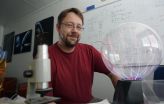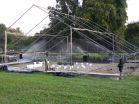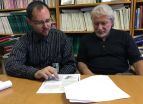The analogy that builds human thought
Abstracting relations between objects: A primary cognitive ability
2015-05-27
(Press-News.org) When Niels Bohr hypothesised his model of atom with the electrons orbiting the nucleus just like satellites orbit a planet, he was engaging in analogical reasoning. Bohr transferred to atoms the concept of "a body orbiting another", that is, he transferred a relation between objects to other, new objects. Analogical reasoning is an extraordinary ability that is unique to the human mind, is not seen in animals (except very rarely in primates) and that forms the basis of highly sophisticated human thoughts. Scientists have wondered about the origin of this cognitive function: for example, is it necessary to have developed linguistic abilities or are we born already cognitively equipped for this type of abstraction? According to a new study carried out with the collaboration of the International School for Advanced Studies (SISSA) of Trieste and just published in Child Development, the second hypothesis is probably true: analogical abilities precede language and are already present in infants just a few months old.
"We worked with the same-different relation, which, as the simplest abstract relation, has been a focus of research on analogical thinking", explains Alissa Ferry, SISSA research fellow and first author of the study. "We investigated two different questions about how humans start to think analogically: First, we asked if language is required to understand abstract relations or if this skill is independent of language. Second, if this is independent of language and humans are born with analogical skills, do humans also naturally possess some knowledge of relations that they use to start thinking analogically? Or are humans born with analogical skills and that their understanding of relations is built from scratch using only these analogical skills.
To answer these questions, Ferry worked with prelinguistic infants aged 7 to 9 months who were trained on same or different pairs of puppets and then tested on their ability to generalize the observed property to novel pairs of objects.
"Even children of that age are able to identify the 'abstract' relation between objects and then recognize it in novel objects, but a single trial in the training phase is not sufficient: they need several trials to understand the relation". This, according to Ferry, means two things: that analogical reasoning is independent of linguistic ability (which it precedes) but we are not born with same-different templates encoded in our brains and we need some experience before we learn it.
More in detail...
By definition, a prelinguistic child is unable to speak and carry out tasks based on instructions given by an experimenter. So how do neuroscientists understand what happens in the child's mind?
"When we work with very young children we use a special technique based on the fact that after a child looks at a cue for a while, his attention will drop in a fairly typical fashion", explains Ferry. Attention is measured by monitoring gaze: if the child's gaze is fixed on the cue, that means the child is paying attention, but when his gaze starts to wander he is no longer paying attention. "We know from the literature that when a child becomes habituated to a stimulus and no longer looks at it, presenting him with something new will bring his gaze back to the stimulus. This gives us a clue to understand whether the child is experiencing something different from before".
In Ferry's study, the children were trained on a pairs of identical (or different, in the alternative condition) objects. The pairs of same objects were left in view until the child's attention started to wane. At that point, the experimenters showed the children two pairs of objects simultaneously: one with two identical puppets and one with different puppets. If the child's gaze went towards the pair of different objects, then the researchers understood that the child had grasped the sameness relation in the training pair and considered the different pair as "novel".
INFORMATION:
USEFUL LINKS:
Original Paper in Child Development: http://goo.gl/8s3xQO
ELSE PRESS RELEASES FROM THIS DATE:
2015-05-27
Jena (Germany) March 1938: The Italian elementary particle physicist Ettore Majorana boarded a post ship in Naples, heading for Palermo. But he either never arrives there - or he leaves the city straight away - ever since that day there has been no trace of the exceptional scientist and until today his mysterious disappearance remains unresolved. Since then, Majorana, a pupil of the Nobel Prize winner Enrico Fermi, has more or less been forgotten. What the scientific world does remember though is a theory about nuclear forces, which he developed, and a very particular elementary ...
2015-05-27
Hodgkin's lymphoma--cancer of the lymph nodes--arises in more than 150 children and adolescents in Germany each year. Nine out of ten patients survive the disease, thanks to the highly effective treatments that are now available. Depending on the type of treatment given, however, there may be late sequelae, as discussed by Wolfgang Dörffel and colleagues in an original article in the current issue of Deutsches Ärzteblatt International (Dtsch Arztebl Int 2015; 112: 320-7). These authors studied the question of which types of treatment were more likely to be followed ...
2015-05-27
An international team of researchers has for the first time predicted the occurrence of aurorae visible to the naked eye on a planet other than Earth.
Mars' upper atmosphere may be indeed closer to Earth's than previously thought. Researchers showed that the upper atmosphere of Mars glows blue depending on the activity of the Sun. The result was achieved through numerical simulation and a laboratory experiment, called the Planeterrella, used to simulate the aurora. The study was published in the leading planetology publication Planetary and Space Science on 26 May.
'The ...
2015-05-27
GAINESVILLE, FL -- As the container nursery industry faces severe restrictions on water use, researchers are looking to identify ways to minimize watering needs and eliminate excess watering. The authors of a new study say that understanding container-grown plants' capacity to "capture" sprinkler irrigation water can give growers important tools that help them adjust irrigation rates, reduce water use, and produce healthy plants.
Jeff Million and Thomas Yeager from the Department of Environmental Horticulture at the University of Florida say that there has been limited ...
2015-05-27
Brisbane flood victims suffered more psychological distress during the rebuilding phase than as waters inundated their homes and businesses, a Queensland University of Technology study has found.
Kelly Dixon, from QUT's School of Psychology and Counselling, has looked at the mental health impacts caused by the Brisbane 2011 and the Mackay 2008 flood disasters.
"The findings showed that aftermath stress contributed to poor mental health outcomes over and above the flood itself, prior mental health issues and demographic factors," Ms Dixon said.
Presenting her findings ...
2015-05-27
In a groundbreaking study published recently in the Journal Psychology, Professor Lea Waters from the Melbourne Graduate School of Education outlines how children can draw on their personal strengths to cope with the demands that lead to stress.
"While some stress such as toxic stress caused by a long lasting intense negative experience can have a debilitating effect on the wellbeing of children, not all stress is bad or damaging," Professor Waters said.
"Positive stress is a normal part of the developmental process. When managed well, it has the potential to help children ...
2015-05-27
Warring armies use a variety of tactics as they struggle to gain the upper hand. Among their tricks is to attack with a decoy force that occupies the defenders while an unseen force launches a separate attack that the defenders fail to notice.
A study published earlier this month in the journal Proceedings of the National Academy of Sciences suggests that the Hepatitis C virus (HCV) may employ similar tactics to distract the body's natural defenses. After infecting patients, Hepatitis C evolves many variants, among them an "altruistic" group of viral particles that appears ...
2015-05-27
Millions of genetic variants have been discovered over the last 25 years, but interpreting the clinical impact of the differences in a person's genome remains a major bottleneck in genomic medicine. In a paper published in The New England Journal of Medicine on May 27, a consortium including investigators from Brigham and Women's Hospital (BWH) and Partners HealthCare present ClinGen, a program to evaluate the clinical relevance of genetic variants for use in precision medicine and research.
"We're dealing with massive amounts of information: more than 80 million genetic ...
2015-05-27
Tremendous advances have been made in decoding the human genome in recent years but critical questions remain regarding what these variants mean and how they can be applied in clinical practice. In a comprehensive paper to be published in The New England Journal of Medicine on May 27, 2015, "ClinGen: The Clinical Genome Resource," a consortium including investigators from the American College of Medical Genetics and Genomics (ACMG) provide a detailed overview of ClinGen, an NIH-supported program to evaluate the clinical relevance of genetic variants for use in precision ...
2015-05-27
Women who eat a Mediterranean diet could cut their risk of womb cancer by more than half (57 per cent), according to a study published today (Wednesday) in the British Journal of Cancer*.
The Italian researchers looked at the diets of over 5,000 Italian women to see how closely they stuck to a Mediterranean diet and whether they went on to develop womb cancer**.
The team broke the Mediterranean diet down into nine different components and measured how closely women stuck to them. The diet includes eating lots of vegetables, fruits and nuts, pulses, cereals and potatoes, ...
LAST 30 PRESS RELEASES:
[Press-News.org] The analogy that builds human thought
Abstracting relations between objects: A primary cognitive ability


